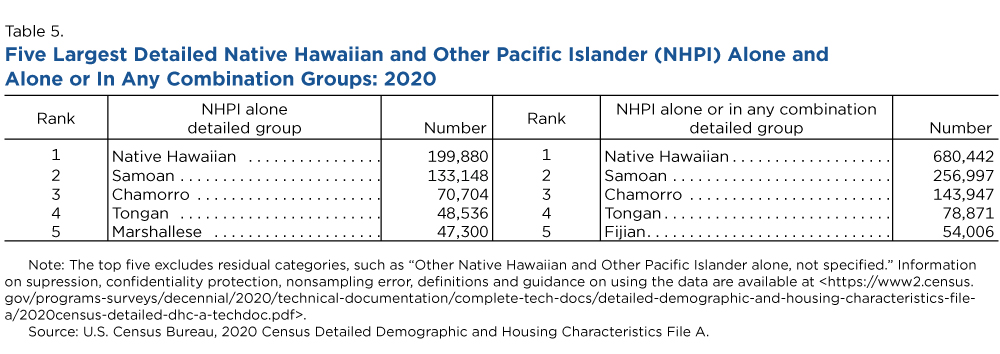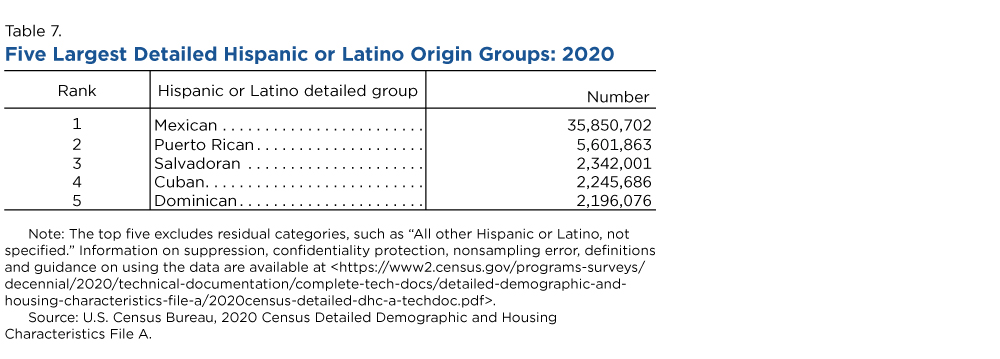Census Bureau Releases 2020 Census Population for More Than 200 New Detailed Race and Ethnicity Groups
Today's release of new 2020 Census data provides population counts of nearly 1,500 race and ethnicity groups and American Indian and Alaska Native (AIAN) tribes and villages.
Some of the most noticeable improvements include the addition of White and Black or African American write-in areas on the questionnaire and the tabulation of detailed Some Other Race responses. These improvements allowed us to provide counts for groups that did not receive data from the race question in previous censuses.
More than 350 million detailed responses to the race and ethnicity questions were collected in the 2020 Census — six times more than in the 2010 Census due to improvements to the race and Hispanic or Latino origin (referred to as Hispanic origin) questions design, data processing and coding procedures.
Some of the most noticeable improvements include the addition of White and Black or African American write-in areas on the questionnaire and the tabulation of detailed Some Other Race responses. These improvements allowed us to provide counts for groups that did not receive data from the race question in previous censuses.
As a result, detailed data are now available for 104 White groups (Dutch, Lebanese, etc.), 62 Black or African American groups (Congolese, Grenadian, etc.) and 22 Some Other Race groups (Brazilian, Belizean, etc.).
The 2020 Census also marks the first time we are releasing data for regional groups, including Middle Eastern and North African, Caribbean, Sub-Saharan African, Polynesian and more.
The Detailed Demographic and Housing Characteristics File A (Detailed DHC-A) released today provides population counts for:
- 30 detailed and four regional Hispanic origin groups.
- 270 detailed race groups.
- 1,187 AIAN tribes and villages.
- 24 regional race groups.
In this release, detailed groups reported in the race question have both “alone” and “alone or in any combination” counts.
The “alone” count represents the minimum number of people who identified as that detailed group, and includes respondents with only one response, such as Hungarian.
The “alone or in any combination” count represents the maximum number of people who identified as that detailed group. It includes respondents with only one response, such as Hungarian, and those with multiple, such as Hungarian and Romanian or Hungarian and Black or African American.
This information is important to frame the discussion of racial and ethnic composition and help us understand our country’s changing demographics as the nation becomes much more multiracial.
Following the 1997 Revisions to the Standards for the Classification of Federal Data on Race and Ethnicity [PDF <1.0 MB], only a single response was tabulated in response to the Hispanic origin question.
Largest U.S. Detailed Race Responses
With the inclusion of new write-in areas, we were able to tabulate detailed responses for all major race categories for the first time.
- Among White respondents, English was the most common detailed group reported in 2020 (Table 1). Over 25.5 million people reported English alone, and 46.6 million people reported English alone or in any combination.
- Among Black or African American respondents, African American was the largest detailed group, with 22.1 million people reporting African American alone and 24.6 million reporting African American alone or in any combination (Table 2).
- The largest alone and alone or in any combination groups differed for AIAN tribes and villages (Table 3). The largest detailed AIAN alone group was Aztec (387,122), which was one of the new examples included in the 2020 Census race question, while Cherokee (1.5 million) was the largest detailed alone or in any combination group.
- Among Asian respondents, Asian Indian (4.4 million) was the largest detailed alone group (Table 4). Chinese, except Taiwanese (5.2 million) was the largest detailed alone or in any combination group.
- The most reported detailed Native Hawaiian and Other Pacific Islander (NHPI) group was Native Hawaiian: nearly 200,000 people identified as Native Hawaiian alone, and 680,442 identified as Native Hawaiian alone or in any combination (Table 5).
- The vast majority (93.9%) of respondents classified as Some Other Race alone were of Hispanic origin.
- The Brazilian population was the largest detailed Some Other Race group, excluding Hispanic responses and “Multiracial and Multiethnic” responses, such as “Biracial,” to the race question (Table 6). There were 145,180 Brazilian alone responses and 524,382 Brazilian alone or in any combination responses.
Detailed Hispanic Origin Population
The Mexican population (35.9 million) was the largest detailed Hispanic origin group in 2020 (Table 7). The next largest were Puerto Rican, Salvadoran, Cuban and Dominican.
The data visualization shows the size and rankings of even more detailed race and ethnicity groups for the nation, states and counties.
Note: Select the image to go to the interactive data visualization.
More Groups Eligible for Population Counts Than Ever Before
In addition to the new detailed White, Black or African American, Some Other Race and regional groups, there were improvements to the code list and tabulations to ensure more detailed Asian, NHPI, AIAN and Hispanic origin groups were available in 2020. These updates include:
- New tabulations for detailed Asian groups: Afghan, Kazakh, Sikh, Uzbek, and more.
- New tabulations for NHPI groups: Maori, Nauruan, Solomon Islander, and more.
- New tabulations for detailed Afro Descendent Hispanic origins: Afro-Latino and Garifuna.
- Lowered population thresholds, which means more detailed AIAN, Asian, NHPI and Hispanic origin groups have published population counts in 2020 than in 2010.
- Based on consultation with tribal leaders, tribal groupings are not included but detailed AIAN tribes and villages are.
What Types of Data Exist for My Group?
We understand the critical importance of providing disaggregated data for myriad population groups, and the goal of this release is to provide as much data at various geography levels for as many detailed racial and ethnic groups and AIAN tribes and villages [XLS <1.0 MB] as confidentiality protections will allow.
To achieve this, the Detailed DHC-A uses an adaptive design [PDF 10.6 MB] to determine the amount of data published based on population size and geography level:
- At the nation and state levels, detailed and regional groups of all sizes will have total population counts.
- Detailed groups with populations of 22 or more will have total population counts at county, census tract and place levels, as well as American Indian/Alaska Native/Native Hawaiian (AIANNH) areas.
- Regional groups with populations of at least 94 will have total population counts at county, census tract and place levels.
- The adaptive design will use thresholds that vary by geography to determine eligibility for sex-by-age tables.
How to Compare Detailed Race and Ethnicity Data to the 2010 Census
Data comparisons between the 2020 Census and 2010 Census race data should be made with caution, taking into account the improvements we have made to the race question and the ways we code what people tell us.
Some of these improvements include differences in how race groups were tabulated in 2010 compared to 2020. For example:
- In 2010, “Sikh” was tabulated as “Asian Indian.” In 2020, it was tabulated on its own.
- In 2010, there was a “Guamanian or Chamorro” checkbox. In 2020, the checkbox was updated to “Chamorro.”
- In 2010, “Niuean” was tabulated as “Tokelauan.” In 2020, it was tabulated on its own.
However, the detailed Hispanic origin data from the ethnicity question are comparable between the two censuses.
For similar updates, data users can reference the Detailed Race and Ethnicity Crosswalk: 2010 to 2020 [XLS <1.0 MB], the 2010 Census Hispanic or Latino Origin and Race Code Lists [PDF 4.5 MB] and the 2020 Census Hispanic Origin and Race Code List [XLS <1.0 MB] for how specific groups were coded in both censuses.
Guidance is Available in Our Technical Documentation
The Detailed DHC-A is unlike other data products most data users are familiar with, such as the American Community Survey (ACS) and previous decennial census releases.
To help data users get the most out of the Detailed DHC-A data, the technical documentation [PDF 10.6 MB] includes guidance on topics such as:
- Comparing to the ACS.
- Calculating percentages.
- Suppressed counts.
- Data aggregation.
- Margins of error.
The technical documentation [PDF 10.6 MB] also discusses some of the known inconsistencies data users may encounter when using the Detailed DHC-A and provides details about the privacy protections implemented to ensure confidentiality.
Data Visualization
Related Information
The technical documentation [PDF 10.6 MB] provides more information on data quality and how the Census Bureau collects, codes and tabulates statistics on race and Hispanic or Latino origin.
Information on the application of differential privacy and data accuracy for the 2020 Census at various levels of geography are available on the 2020 Census Data Products: Disclosure Avoidance Modernization webpage.
2020 Census Detailed Demographic and Housing Characteristics File A on America Counts
9/21
9/26
10/3
10/10
10/17
10/24
Related Statistics
-
Multiracial Heritage Week: June 7-14, 2023The 2020 Census shows the U.S. “Two or More Races” population at 33.8 million — up from 9 million in 2010, a 276% increase.
-
2020 CensusThe 2020 Census marked the 24th count of the U.S. population and the first time that households were invited to respond to the census online.
-
America Counts: 2020 Census StoriesSee all stories on the 2020 Census, from data collection and promotion to the results of the decennial count that give us a complete portrait of America.
-
RaceThe data on race and ethnicity were derived from answers to the question on race and ethnicity that was asked of individuals in the United States.
-
America Counts: Stories About Race
-
Hispanic OriginPeople who identify with the terms “Hispanic” or “Latino” are those who classify themselves in one of the specific Hispanic or Latino categories.
-
America Counts: Stories About Hispanic Origin
Subscribe
Our email newsletter is sent out on the day we publish a story. Get an alert directly in your inbox to read, share and blog about our newest stories.
Contact our Public Information Office for media inquiries or interviews.
-
AsianAsian Indian Was The Largest Asian Alone Population Group in 2020September 21, 2023Detailed 2020 Census data on 41 Asian groups released today show Chinese, Except Taiwanese, was largest Asian alone or in any combination group.
-
Population3.5 Million Reported Middle Eastern and North African Descent in 2020September 21, 2023Detailed data available from the 2020 Census for 26 Middle Eastern and North African groups.
-
PopulationDetailed Look at Native Hawaiian and Other Pacific Islander GroupsSeptember 21, 20232020 Census data released this month provides detailed counts of 31 Native Hawaiian and Other Pacific Islander (NHPI) groups.
-
PopulationWhich States Had the Highest Shares of Newcomers?April 29, 2025Many states with the highest share of recent movers from out-of-state in 2023 had relatively small populations.
-
Business and EconomyEntertainment, Travel, and Recreation Industries ReboundingApril 23, 2025A look at which selected travel, entertainment and recreation-related industries hit hard by the pandemic rebounded.
-
Income and PovertyNew Snapshots From the Survey of Income and Program ParticipationApril 21, 2025New Census Bureau product offers mobile-friendly fact sheets on who receives income from various sources.
-
PopulationU.S. Metro Areas Experienced Population Growth Between 2023 and 2024April 17, 2025New Census Bureau population estimates show 88% of U.S. metro areas gained population between 2023 and 2024.














